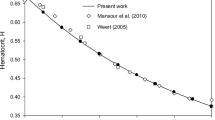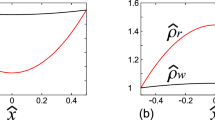Abstract
A kinetic theory based two phase flow model for plasma and red blood cells (RBCs) is shown to explain the Fahraeus–Lindqvist effect, the migration of red blood cells from the wall to the center in narrow tubes. The migration is caused by shear induced diffusion which in the kinetic theory based model is computed using a balance of granular temperature, the random kinetic energy for red blood cells per unit mass. The computed hematocrit distribution agrees with experimental measurements using a complete computational fluid dynamic model and an approximate fully developed flow solution. The model predicts the momentum and granular temperature boundary layers. The model computes the observed blood viscosity dependence on diameter and hematocrit.












Similar content being viewed by others
Abbreviations
- C D :
-
Drag coefficient
- D :
-
Optical density
- d p :
-
Diameter of RBC
- e :
-
Restitution coefficient
- e w :
-
Wall restitution coefficient
- \( \vec{g} \) :
-
Gravitational acceleration
- g 0 :
-
Radial distribution function
- Hct:
-
Hematocrit
- \( {\vec{\vec{\rm I}}} \) :
-
Unit tensor
- k :
-
Extinction coefficient of the absorbing medium
- k s :
-
Granular conductivity
- l :
-
Length of the light passing through
- M s :
-
Molecular weight
- n :
-
Normal component
- P :
-
Pressure
- P s :
-
Solid pressure
- R :
-
Tube radius
- Re p :
-
Reynolds number
- q :
-
Flux of random kinetic energy
- t :
-
Time
- U ∞ :
-
Free stream velocity
- \( \vec{\upsilon }_{\text{f}} \) :
-
Fluid phase velocity vector
- \( \vec{\upsilon }_{\text{s}} \) :
-
Solid phase velocity vector
- υ s,w :
-
RBC velocity in the direction parallel to the wall
- υ sz :
-
Solid phase velocity in axial direction
- υ z,max :
-
Maximum solid phase velocity
- β :
-
Drag coefficient between particles
- ρ f :
-
Fluid density
- ρ s :
-
RBC density
- ε f :
-
Volume fraction of fluid phase
- ε s :
-
Volume fraction of solid phase
- ε s,max :
-
Maximum solid volume fraction
- \( {\vec{\vec{\tau}}}_{\text{f}} \) :
-
Stress tensor of fluid phase
- τ rz :
-
The stress in the z direction acting on the surface perpendicular to the r direction
- \( \vec{\vec{\tau }}_{\text{s}} \) :
-
Stress tensor of solid phase
- θ :
-
Granular temperature
- θ w :
-
Granular temperature at the wall
- γ :
-
Energy dissipation due to inelastic collision of particles
- γ w :
-
Energy dissipation due to inelastic collision between particle and the wall
- μ f :
-
Fluid viscosity
- μ s :
-
Solid viscosity
- ξ s :
-
Bulk viscosity of solid phase
- ϕ :
-
Specularity coefficient
- ν :
-
Kinematic viscosity
- δ :
-
Boundary layer thickness
- δ T :
-
Granular temperature boundary layer thickness
References
Bagchi, P. 2007 Mesoscale simulation of blood flow in small vessels. Biophys. J. 92: 1858-1877. doi:10.1529/biophysj.106.095042
Benyahia, S. 2008 Verification and validation study of some polydisperse kinetic theories. Chem. Eng. Sci. 63(23): 5672-5680.
Bird, R. B., W. E. Stewart, and E. N. Lightfoot 2002 Transport Phenomena, 2nd edition. New York: Wiley.
Bishop, J. J., A. S. Popel, M. Intaglietta, and P. C. Johnson 2002 Effect of aggregation and shear rate on the dispersion of red blood cells flowing in venules. Am. J. Physiol Heart Circ Physiol. 283: 1985-1996.
Brooks, D. E., J.W. Goodwin, and G. V. F. Seaman 1970 Interactions among erythrocytes under shear. J. Appl. Physiol. 28:172–177.
Bugliarello, G., and J. W. Hayden 1962 High-speed microcinematographyic studies of blood in vitro. Science 138: 981-983. doi:10.1126/science.138.3544.981
Chapman, S., and T. G. Cowling 1961 The Mathematical Theory of Non-uniform Gases, 2nd edition. Cambridge: Cambridge University Press.
Cokelet, G. R., and H. L. Goldsmith 1991 Decreased hydrodynamic resistance in the two-phase flow of blood through small vertical tubes at low flow rates. Circulation Research 68: 1-17.
Damiano, E. R., D. S. Long, and M. L. Smith 2004 Estimation of viscosity profiles using velocimetry data from parallel flows of linearly viscous fluids: application to microvascular hemodynamics. J. Fluid Mech. 512: 1-19. doi:10.1017/S0022112004008766
Ethier, R. C. 2002 Computational modeling of mass transfer and links to atherosclerosis. Ann. Biomed. Eng. 30: 461-471. doi:10.1114/1.1468890
Fahraeus, R., and T. Lindqvist 1931 The viscosity of the blood in narrow capillary tubes. Am. J. Physiol. 96: 562-568.
Gidaspow, D. 1994 Multiphase Flow and Fluidization: Continuum and Kinetic Theory Descriptions. New York: Academic Press
Gidaspow, D., and H. Lu 1996 Collisional viscosity of FCC particles in a CFB. AICHE J. 42: 2503-2510. doi:10.1002/aic.690420910
Gidaspow, D., and H. Lu 1998 Equation of state and radial distribution functions of FCC particles in a CFB. AICHE J. 44: 279-292. doi:10.1002/aic.690440207
Gidaspow, D., J. Jung, and R. K. Singh 2004 Hydrodynamics of fluidization using kinetic theory: an emerging paradigm 2002. Flour-Daniel Lecture. Powder Tech. 148: 123-141. doi:10.1016/j.powtec.2004.09.025
Gijsen, F. J. H., F. N. Vande Vosse, and J. D. Janssen 1999 The influence of the non-Newtonian properties of blood on the flow in large arteries: Steady flow in a carotid bifurcation model. J.Biomech. 32:601–608. doi:10.1016/S0021-9290(99)00015-9
Goldsmith, H. L. 1971 Red cell motions and wall interactions in tube flow. Fed. Proc. 30: 1578-1590.
Goldsmith, H. L., G. R. Cokelet, P. Gaehtgens 1989 Robin Fahraeus: evolution of his concepts in cardiovascular physiology. Am. J. Physiol. 257: H1005–H1015.
Happel, J., and H. Brenner 1983 Low Reynolds Number Hydrodynamics. New York: Kluwer.
Haynes, R. H. 1960 Physical basis of the dependence of blood viscosity on tube radius. Am. J. Physiol. 198: 1193-1200.
He, X., and D. N. Ku 1996 Pulsatile flow in the human left coronary artery bifurcation: average conditions. J. Biomech. Eng. 118: 74-82. doi:10.1115/1.2795948
Hoi, Y., H. Meng, S. H. Woodward, B. R. Bendok, R. A. Hanel, L. R. Guterman, and L. N. Hopkins 2004 Effect of arterial geometry on aneurysm growth: Three-dimensional computational fluid dynamics study. J. Neurosurg. 101:676–681
Hsiau, S. S., and M. L. Hunt 1996 Granular thermal diffusion in flows of binary-sized mixture. Acta Mechanica 114: 121-137. doi:10.1007/BF01170399
Jackson, R. 2000 The Dynamics of Fluidized Particles. Cambridge: Cambridge University Press.
Johnson, P. C., and R. Jackson 1987 Frictional-constitutive relations for granular materials, with application to plane shearing. J. Fluid Mech. 176: 67-93. doi:10.1017/S0022112087000570
Jung, J., R. W. Lyczkowski, C. B. Panchal, and A. Hassanein 2006a Multiphase hemodynamic simulation of pulsatile flow in a coronary artery. Journal of Biomechanics 39: 2064-2073. doi:10.1016/j.jbiomech.2005.06.023
Jung, J., A. Hassanein and R. W. Lyczkowski 2006b Hemodynamic computation using multiphase flow dynamics in a right coronary artery. Annals of Biomedical Engineering 34: 393-407. doi:10.1007/s10439-005-9017-0
Limtrakul, S., J. Chen, P. A. Ramachandran, and M. P. Dudukovic 2005 Solid motion and holdup profiles in liquid fluidized beds. Chem. Eng. Science 60: 1889-1900. doi:10.1016/j.ces.2004.11.026
Long, D. S., M. L. Smith, A. R. Pries, K. Ley, and E. R. Damiano 2004 Microvescometry reveals reduced blood viscosity and altered shear rate and shear stress profiles in microvessels after hemodilution. Proc. Natl. Acad. Sci. USA. 101: 10060-10065. doi:10.1073/pnas.0402937101
Lu, H., D. Gidaspow, and E. Manger. Kinetic theory of fluidized binary granular mixtures. Phys. Rev. E 64:061301-1–061301-8, 2001.
Lu, H., and D. Gidaspow 2003 Hydrodynamics of binary fluidization in a riser: CFD simulation using two granular temperatures. Chem. Eng. Sci. 58: 3777-3792. doi:10.1016/S0009-2509(03)00238-0
Lyon, M. K., and L.G. Leal 1998 An experimental study of the motion of concentrated suspensions in two-dimensional channel flow. Part 1. monodisperse system. J. Fluid Mech. 363: 25-56. doi:10.1017/S0022112098008817
Nair, P. K., J. D. Hellums, and J. S. Olson 1989 Prediction of oxygen transport rates in blood flowing in large capillaries. Microvascular Research 38: 269-285. doi:10.1016/0026-2862(89)90005-8
Nerem, R. M. 1995 Atherosclerosis and the role of wall shear stress. In: J. Bevan, G. Kaley, and G. M. Rubany (eds) Flow Dependent Regulation of Vascular Function. Oxford University Press, New York, pp. 300-319.
Phillips, R. J., R. C. Armstrong, R. A. Brown, A. L. Graham, and J. R. Abott 1992 A constitutive equation for concentrated suspensions that accounts for shear-induced particle migration. Phys. Fluids A 4: 30-40. doi:10.1063/1.858498
Pries, A. R., D. Neuhaus, and P. Gaehtgens 1992 Blood viscosity in tube flow: dependence on diameter and hematocrit. Am J Physiol Heart Circ Physiol 263: H1770–H1778.
Savage, S. B. 1983 Granular flow at high shear rates. In: R. E. Meyer (eds) Theory of Dispersed Multiphase Flow. New York: Academic Press, pp. 339-358.
Schlighting, H. 1955 Boundary layer theory. London: Mcgraw-Hill.
Sharan, M., and A. S. Popel 2001 A two-phase model for flow of blood in narrow tubes with increased effective viscosity near the wall. Biorheology 38: 1578-1590.
Sinclair, J. L., and R. Jackson 1989 Gas-particle flow in a vertical pipe with particle-particle interactions. AICHE J. 35: 1473-1486. doi:10.1002/aic.690350908
Stadler, A. A., E. P. Zilow, and O. Linderkamp 1990 Blood viscosity and optimal hematocrit in narrow tubes. Biorheology 27: 779-788.
Steinman, D. A. 2002 Image-based computational fluid dynamics modeling in realistic arterial geometries. Ann. Biomed. Eng. 30: 483–497. doi:10.1114/1.1467679
Tartan, M., and D. Gidaspow 2004 Measurement of granular temperature and stresses in risers. AICHE J. 50: 1760-1775. doi:10.1002/aic.10192
Taylor, M. 1955 The flow of blood in narrow tubes II. The axial stream and its formation, as determined by changes in optical density. Austral J. Exp. Biol. 33: 1-16. doi:10.1038/icb.1955.1
Tsuo, Y. P., and D. Gidaspow 1990 Computation of Flow Patterns in Circulating Fluidized Beds. AIChE J. 36: 885-896. doi:10.1002/aic.690360610
Wen, C. Y., and Y. H. Yu 1966 Mechanics of fluidization. Chem. Eng. Prog. Symp. Seriers 62: 100-111.
Acknowledgments
The award of an Illinois Institute of Technology Fieldhouse Fellowship to the second author was instrumental in enabling the research presented herein. We also thank Sofiane Benyahia of the US Department of Energy, NETL, for helping us to delete the fluid–particle interaction term in the granular temperature equation in FLUENT.
Author information
Authors and Affiliations
Corresponding author
Rights and permissions
About this article
Cite this article
Gidaspow, D., Huang, J. Kinetic Theory Based Model for Blood Flow and its Viscosity. Ann Biomed Eng 37, 1534–1545 (2009). https://doi.org/10.1007/s10439-009-9720-3
Received:
Accepted:
Published:
Issue Date:
DOI: https://doi.org/10.1007/s10439-009-9720-3




